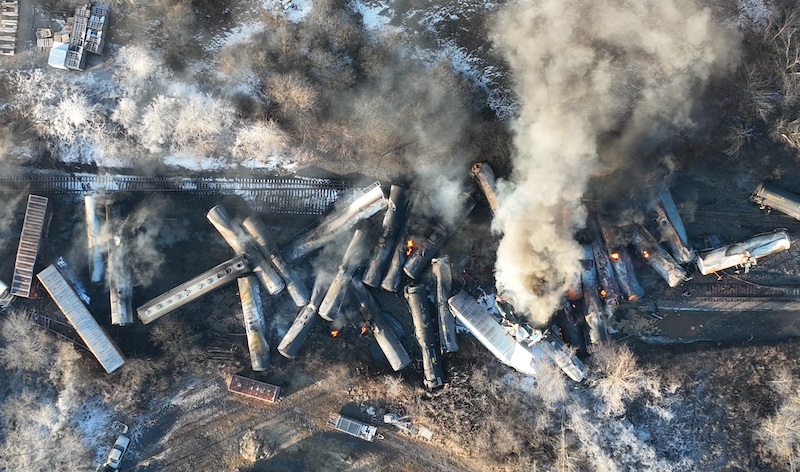By Justin Franz
The federal government is taking aim at Norfolk Southern and the wider railroad industry following the explosive derailment in East Palestine, Ohio, two weeks ago.
This week, the U.S. Department of Transportation announced it would be pushing for stronger regulations on the nation’s freight railroads in the wake of the incident. Among the initiatives the department will push for include the use of electronically controlled pneumatic brakes on high-hazard unit trains; the replacement of all older tank cars to the stronger and safer DOT 117 type; and a rule that would require all freight trains to have at least two people in the cab. The department also called on Congress to take action.
“Profit and expediency must never outweigh the safety of the American people,” said U.S. Transportation Secretary Pete Buttigieg, who was expected to visit East Palestine this week. “We at USDOT are doing everything in our power to improve rail safety, and we insist that the rail industry do the same – while inviting Congress to work with us to raise the bar.”
Meanwhile, the U.S. Environmental Protection Agency took control of the clean-up in East Palestine, while also announcing that NS would be footing the bill for what will most likely be a long-term effort.
“The Norfolk Southern train derailment has upended the lives of East Palestine families, and EPA’s order will ensure the company is held accountable for jeopardizing the health and safety of this community,” said EPA Administrator Michael S. Regan. “Let me be clear: Norfolk Southern will pay for cleaning up the mess they created and for the trauma they’ve inflicted on this community. I’m deeply grateful to the emergency responders, including EPA personnel, who’ve been on the ground since day one and ensured there was no loss of life as a result of this disaster. As we transition from emergency response, EPA will continue to coordinate closely with our local, state, and federal partners through a whole-of-government approach to support the East Palestine community during the remediation phase. To the people of East Palestine, EPA stands with you now and for as long as it may take.”
While federal leaders were looking to take action, the railroads were urging caution. In a statement this week, Association of American Railroads President and CEO Ian Jefferies said that the National Transportation Safety Board’s investigation of the incident should be completed before anything more is done.
“The NTSB’s independent investigators continue their work to identify the accident’s root cause and contributing factors. That investigation must continue unimpeded by politics and speculation so NTSB’s findings can guide what additional measures may have prevented this accident,” he said. “All stakeholders – railroads along with federal, state and local officials – must work to restore the public’s trust in the safety and security of our communities. We can only do that by letting the facts drive the post-accident response. At this time, the focus must be on the most pressing issue at hand – ensuring the community of East Palestine has all the support they need as it moves forward.”
The NTSB was expected to release it preliminary findings into the wreck on Thursday.
Late on February 3, NS train 32N derailed in East Palestine, Ohio, as the result of an overheated wheel bearing, according to the National Transportation Safety Board. Thirty-eight of the train’s 150 cars derailed, of which 11 were carrying hazardous materials. The derailment sparked a fire, forcing evacuations nearby. Three days later, on February 6, NS conducted a “controlled release” of some of the cars carrying vinyl chloride, a dangerous gas used to make plastic products, because it was concerned the tank cars might explode. More residents were evacuated before the release and told that if they stayed they were in “grave danger of death.” NS later said the release was “successful” and residents were able to return to their homes a few days later.
But since then, local residents have grown concerned about the homes and town they returned to. Fish are turning up dead in area creeks, local residents are reporting unexplained rashes and they are unsure if the water is safe to drink, despite assurances that it is from state and local officials. As the days have gone on, anger has replaced the clouds of smoke that billowed from NS’ “controlled release.”



